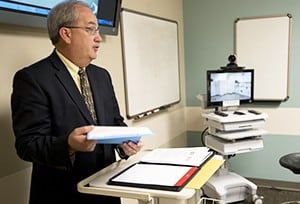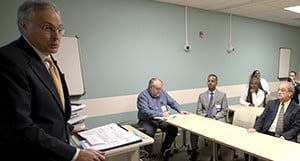World Stroke Day Simulation at UAMS Raises Stroke Awareness
Oct. 29, 2014 | Physicians and an actor used stagecraft and a touch of drama Oct. 29 to demonstrate what 30 Arkansans a day will experience — having a stroke. They also showed how a statewide program called AR SAVES (Arkansas Stroke Assistance through Virtual Emergency Support) program uses telemedicine to improve health outcomes for stroke patients across Arkansas. The mock event held in the UAMS Simulation Center was part of World Stroke Day activities to raise public awareness of the risks and symptoms of stroke and what can be done to improve recovery from one. The simulation was organized by the UAMS-led AR SAVES program, the Arkansas Heart Association/Arkansas Stroke Association and the Arkansas Department of Health. “We want to give you a look at what we do in 45 emergency departments across the state of Arkansas,” said UAMS’ Michael Manley, AR SAVES director. “No other state does this as big as we do statewide. AR SAVES covers many different kinds of hospitals, too.” Tony Seupaul, M.D, chair of the UAMS College of Medicine Department of Emergency Medicine, played the part of an emergency physician at an AR SAVES hospital and interviewed a simulated patient, actor Candyce Hinkle, about her symptoms as Metropolitan Emergency Medical Services personnel wheeled her on a gurney into an exam room in the Simulation Center. Although she was in a nearby room, Margaret Tremwel, M.D., performed as a stroke neurologist in another city consulting through live video with Seupaul and Hinkle about her symptoms. Tremwel is a stroke neurologist at Washington Regional Medical Center in Fayetteville and one of several on call with the AR SAVES program. Seupaul tested Hinkle’s motor skills by asking her to pretend to hold up a pizza box and her language skills by repeating the phrase, “It’s a sunny day in Cincinnati.” Hinkle showed she had limited range of motion in her left arm, and her speech was slurred. Tremwel recommended she receive a powerful blood-clot dissolving agent, and the demonstration concluded shortly after. AR SAVES uses a high-speed video communications system to help provide immediate, life-saving treatments to stroke patients 24 hours a day. The real-time video communication enables a stroke neurologist to evaluate whether emergency room physicians should use the blood-clot dissolving agent within the critical three-hour period following the first signs of stroke. “Arkansas is a rural state, but it’s one with someone nearly everywhere,” said UAMS Chancellor Dan Rahn, M.D. “There are no big expanses without any one living there. More than 50 percent of the state’s population lives in a rural area. How do we expand medical expertise from urban centers to those areas so geography is not a determinant of a health care outcome in the event of an emergency like a stroke? Arkansas SAVES is an innovative solution to that challenge.” The program is a partnership between the UAMS Center for Distance Health, the state Department of Human Services, Sparks Regional Health System in Fort Smith and 43 other Arkansas hospitals. Arkansas Rep. Kim Hammer, a hospice chaplain at Saline Memorial Hospice, presented a certificate of proclamation from Gov. Mike Beebe declaring the state’s participation in World Stroke Day. Although Arkansas has cut its rate of stroke death in half since 1970, it remains first in the nation for stroke deaths, said Joe Bates, M.D., chief medical director for the Arkansas Department of Health. “We have about 30 strokes every day in Arkansas and about five of those die,” Bates said. “Of the 25 who survive, most of them are not able to return to gainful employment or a normal life. Many end up in nursing homes; the single biggest expenditure for Medicaid in Arkansas is for nursing home care and many of them are there because of strokes. It’s an enormous problem.” Both Bates and Tremwel praised the Arkansas Heart Association and Arkansas Department of Health for the creation and maintenance of the Arkansas Stroke Registry, a database of more than 10,000 stroke patients in Arkansas. Many hospitals participating in AR SAVES use the registry. “If you can look at your data, then you can improve your data,” Tremwel said. “This registry is going out to many hospitals. We can look at the data and improve our outcomes. The registry also is an important prevention piece.” Manley said the speed with which patients are being diagnosed for stroke and receiving treatment is increasing at AR SAVES hospitals. Stroke patients in Arkansas who receive the blood-clot dissolving agent have risen from less than 1 percent to 33 percent. He said the state will not remain first in stroke deaths for much longer. “World Stroke Day is meant to draw attention to the fact that something can be done about stroke,” said Barbara Kumpe, Arkansas Heart Association government relations director. “Many people think, ‘Oh, it’s a stroke. I just have to live with it.’ That’s not true. We know that. There is a three-hour window for treatment that we need to make sure people know about.”
|


